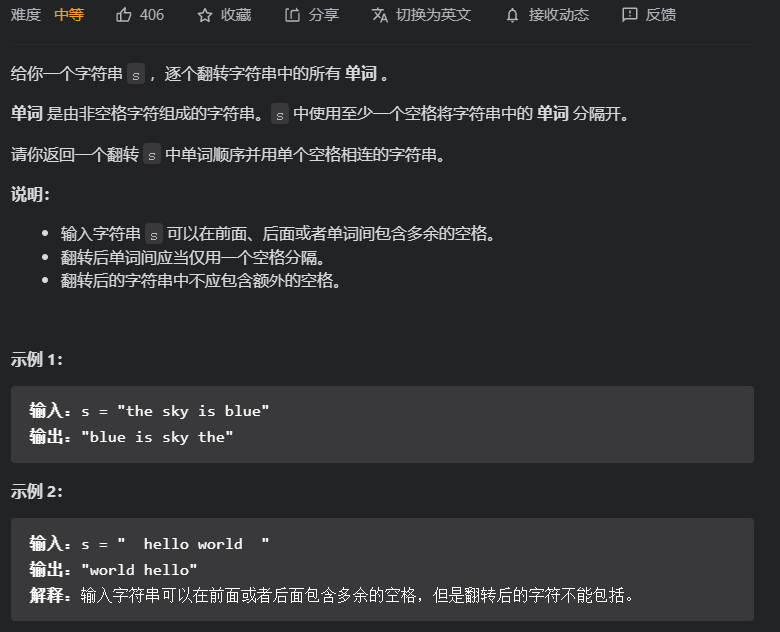题目
leetcode:151翻转字符串里的单词
有一点要注意:字符数组注意传指针

题解与分析
方法一
想到的第一个方法是调api,(我是一个冷酷无情的api杀手:smiling_imp:)
先split然后入栈,再组装
然鹅:使用split库函数,分隔单词,然后定义一个新的string字符串,最后再把单词倒序相加,那么这道题题目就失去了它的意义。

class Solution:
def reverseWords(self, s: str) -> str:
lis = []
tmp = s.split(" ")
for x in tmp:
if x!=' 'and x!="":
lis.insert(0, x)
print(lis)
ret = " ".join(lis)
return ret
方法二
这是我没有想到的
- 先去掉首尾以及中间多余空格
- 反转整个字符串
- 找到单词边界,反转单词
里面有一点要注意,反转单词的时候,最后右边的边界和之前不一样了
移除多余空格时,虽然标注的移除首空格,但那时候并没有移除,只是把fastIndex索引迁移了,在移除中间多余空格的时候才进行移除。
删除尾部空格的时候 可以用切片。

func reverseWords(s string) string {
slowIndex, fastIndex := 0, 0
b := []byte(s)
//1.使用双指针删除冗余的空格
removeRedundantString(&b, fastIndex, slowIndex)
fmt.Println("str:'", string(b), "'")
//2.反转整个字符串
left, right := 0, len(b)-1
reverse(&b, left, right)
fmt.Println("str:'", string(b), "'")
//3.反转单个单词 i单词开始位置,j单词结束位置
left, right = 0, 0
reverseWord(&b, left, right)
fmt.Println(string(b))
return string(b)
}
// removeRedundantString 移除多余空格
func removeRedundantString(b *[]byte, fastIndex, slowIndex int) {
//删除头部冗余空格
// 实际上这一步并没有删除,他只是移动了索引, 到删除单词间冗余空格才从实际上删除
for len(*b) > 0 && fastIndex < len(*b) && (*b)[fastIndex] == ' ' {
fastIndex++
}
//删除单词间冗余空格
for ; fastIndex < len(*b); fastIndex++ {
if fastIndex-1 > 0 && (*b)[fastIndex-1] == (*b)[fastIndex] && (*b)[fastIndex] == ' ' {
continue
}
// 下面才开始双指针的骚操作,进行删除了
(*b)[slowIndex] = (*b)[fastIndex]
slowIndex++
}
//删除尾部冗余空格
// 利用切片来删除
if slowIndex-1 > 0 && (*b)[slowIndex-1] == ' ' {
*b = (*b)[:slowIndex-1]
} else {
*b = (*b)[:slowIndex]
}
}
// reverseWord 反转单词
func reverseWord(b *[]byte, left, right int) {
for left <= right && right <= len(*b)-1 {
if (*b)[right] == ' ' || right == len(*b)-1 {
// 因为最后右边的边界和之前不一样了
if right == len(*b)-1 {
right += 1
}
reverse(&*b, left, right-1)
left = right + 1
}
right++
}
}
// reverse 是反转函数,不管局部还是整体,通杀
func reverse(b *[]byte, left int, right int) {
for left <= right {
//b[left], b[right] = b[right], b[left]
(*b)[left], (*b)[right] = (*b)[right], (*b)[left]
left++
right--
}
}
下面是没有进行封装的代码,方便理解
func reverseWords(s string) string {
//1.使用双指针删除冗余的空格
slowIndex, fastIndex := 0, 0
b := []byte(s)
//删除头部冗余空格
// 实际上这一步并没有删除,他只是移动了索引, 到删除单词间冗余空格才从实际上删除
for len(b)>0&&fastIndex<len(b)&&b[fastIndex]==' '{
fastIndex++
}
//删除单词间冗余空格
for ;fastIndex<len(b); fastIndex++{
if fastIndex-1>0&&b[fastIndex-1]==b[fastIndex]&&b[fastIndex]==' '{
continue
}
// 下面才开始双指针的骚操作,进行删除了
b[slowIndex]=b[fastIndex]
slowIndex++
}
fmt.Println("1 str:'", string(b), "'")
//删除尾部冗余空格
// 利用切片来删除
if slowIndex-1>0&&b[slowIndex-1]==' '{
b = b[:slowIndex-1]
}else{
b = b[:slowIndex]
}
fmt.Println("2 str:'", string(b), "'")
//2.反转整个字符串
left, right := 0, len(b)-1
reverse(&b, left, right)
fmt.Println("str:'", string(b), "'")
//3.反转单个单词 i单词开始位置,j单词结束位置
left, right = 0,0
for left<=right&&right<=len(b)-1{
if b[right]==' '||right==len(b)-1{
if right==len(b)-1{
right+=1
}
reverse(&b, left, right-1)
left = right+1
}
right++
}
return string(b)
}
func reverse(b *[]byte, left int, right int){
for left<=right{
// b[left], b[right] = b[right], b[left]
(*b)[left], (*b)[right] = (*b)[right], (*b)[left]
left++
right--
}
}



